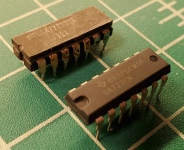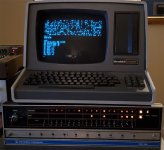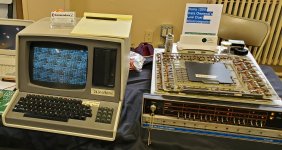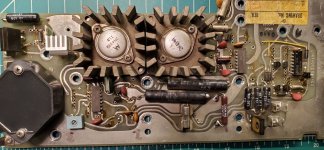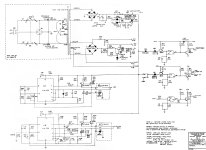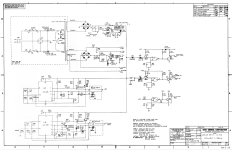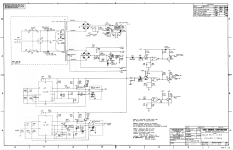CommodoreZ
Experienced Member
I'm well overdue to post updates on this thread, so here goes:
The Nova 1200 is up and running now!
Step one was verifying that the power supply was operational. I started by reforming the 5 large electrolytic capacitors. The smallest of which was too far gone to be reformed and was replaced, while the other 4 performed well enough to be reinstalled. Initial tests with dummy loads attached to the important power rails resulted in a fuse instantly blowing each time I applied power. The fault was traced to a massive diode bridge rectifier which had a short between two contacts, so it was replaced. After that, the power rails tested good under dummy load, ripple was rather minimal. It produces an interesting squeal when running, which changes based on the load, but apparently that's common for this era of Nova.
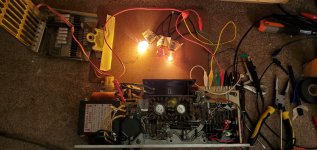
Next, I powered up the machine incrementally with a piece at a time.
First, the front panel. Success. Then the processor board. Success, but you can only test so much of the front panel lamps and switches with just the processor.

I installed an 8K core memory board and powered up the system, and after finding the address of the memory, I was able to confirm that I could read and write to memory.
After that, a friend of mine was fascinated with the machine, and offered to assemble a simple test program to see if the machine was able to actually compute something. We started with a simple jump test, and then moved up to a Fibonacci number calculation test, which it passed just fine. You can watch that in action here:
With that out of the way, the machine sat for a bit while I sorted out my serial board situation because there isn't much I can do with the machine without practical I/O. The two serial boards I had were either:
A: not documented in the slightest (the CompuScan OEM multi I/O board)
B: not intended for use as a primary serial interface (Quad Multiplexer, I suspect it to be a 4063)
In the meantime, I got my core memory situation sorted out a bit better. I was able to confirm 3 out of 4 8K boards worked fine. The last one produces all 1's on the data bus, but that's a problem for another time. The remaining 3 were jumpered to form a contiguous 24K address space, and installed in the machine.
I was able to find someone selling a 4075 online, and with help from Nevets01 confirming that it was the correct type of board I would need, I purchased it. I configured it and ran some tests, which indicated that a single transistor in the TTL to RS232 level conversion circuit had failed. After replacing it, I was able to confirm TX from the Nova at 9600 baud -- blazing fast for a 1971 machine! Upon passing the ASCII spam test, I moved onto a serial echo/parrot test, which it passed handily.
Then it was time for the big test: running single-user BASIC. I toggled in the bootloader to the top of memory (which happened to mostly be there already because core memory), and then sent the Binary Loader over serial. After that passed, I loaded BASIC over serial, and got a prompt! BASIC works well, and the machine is operational! I need to make a video demonstrating BASIC and some glorious blinkenlights next.
The aforementioned friend who assembled my test code also happens to have written a Nova assembler, which you can find here: https://github.com/Quantx/dgnsdk
I created this ( https://www.commodorez.com/nova.html ) page to centralize what I'm doing with the 1200, but I'll try to remember to post updates here more regularly.
Lastly, I want to thank everyone who helped me get this far, as this was a big deal for me to reach these first major goals for my Nova.
The Nova 1200 is up and running now!
Step one was verifying that the power supply was operational. I started by reforming the 5 large electrolytic capacitors. The smallest of which was too far gone to be reformed and was replaced, while the other 4 performed well enough to be reinstalled. Initial tests with dummy loads attached to the important power rails resulted in a fuse instantly blowing each time I applied power. The fault was traced to a massive diode bridge rectifier which had a short between two contacts, so it was replaced. After that, the power rails tested good under dummy load, ripple was rather minimal. It produces an interesting squeal when running, which changes based on the load, but apparently that's common for this era of Nova.

Next, I powered up the machine incrementally with a piece at a time.
First, the front panel. Success. Then the processor board. Success, but you can only test so much of the front panel lamps and switches with just the processor.

I installed an 8K core memory board and powered up the system, and after finding the address of the memory, I was able to confirm that I could read and write to memory.
After that, a friend of mine was fascinated with the machine, and offered to assemble a simple test program to see if the machine was able to actually compute something. We started with a simple jump test, and then moved up to a Fibonacci number calculation test, which it passed just fine. You can watch that in action here:
With that out of the way, the machine sat for a bit while I sorted out my serial board situation because there isn't much I can do with the machine without practical I/O. The two serial boards I had were either:
A: not documented in the slightest (the CompuScan OEM multi I/O board)
B: not intended for use as a primary serial interface (Quad Multiplexer, I suspect it to be a 4063)
In the meantime, I got my core memory situation sorted out a bit better. I was able to confirm 3 out of 4 8K boards worked fine. The last one produces all 1's on the data bus, but that's a problem for another time. The remaining 3 were jumpered to form a contiguous 24K address space, and installed in the machine.
I was able to find someone selling a 4075 online, and with help from Nevets01 confirming that it was the correct type of board I would need, I purchased it. I configured it and ran some tests, which indicated that a single transistor in the TTL to RS232 level conversion circuit had failed. After replacing it, I was able to confirm TX from the Nova at 9600 baud -- blazing fast for a 1971 machine! Upon passing the ASCII spam test, I moved onto a serial echo/parrot test, which it passed handily.
Then it was time for the big test: running single-user BASIC. I toggled in the bootloader to the top of memory (which happened to mostly be there already because core memory), and then sent the Binary Loader over serial. After that passed, I loaded BASIC over serial, and got a prompt! BASIC works well, and the machine is operational! I need to make a video demonstrating BASIC and some glorious blinkenlights next.
The aforementioned friend who assembled my test code also happens to have written a Nova assembler, which you can find here: https://github.com/Quantx/dgnsdk
I created this ( https://www.commodorez.com/nova.html ) page to centralize what I'm doing with the 1200, but I'll try to remember to post updates here more regularly.
Lastly, I want to thank everyone who helped me get this far, as this was a big deal for me to reach these first major goals for my Nova.


